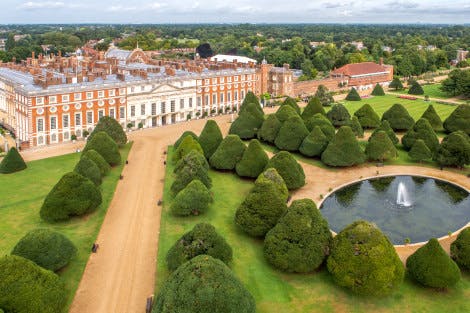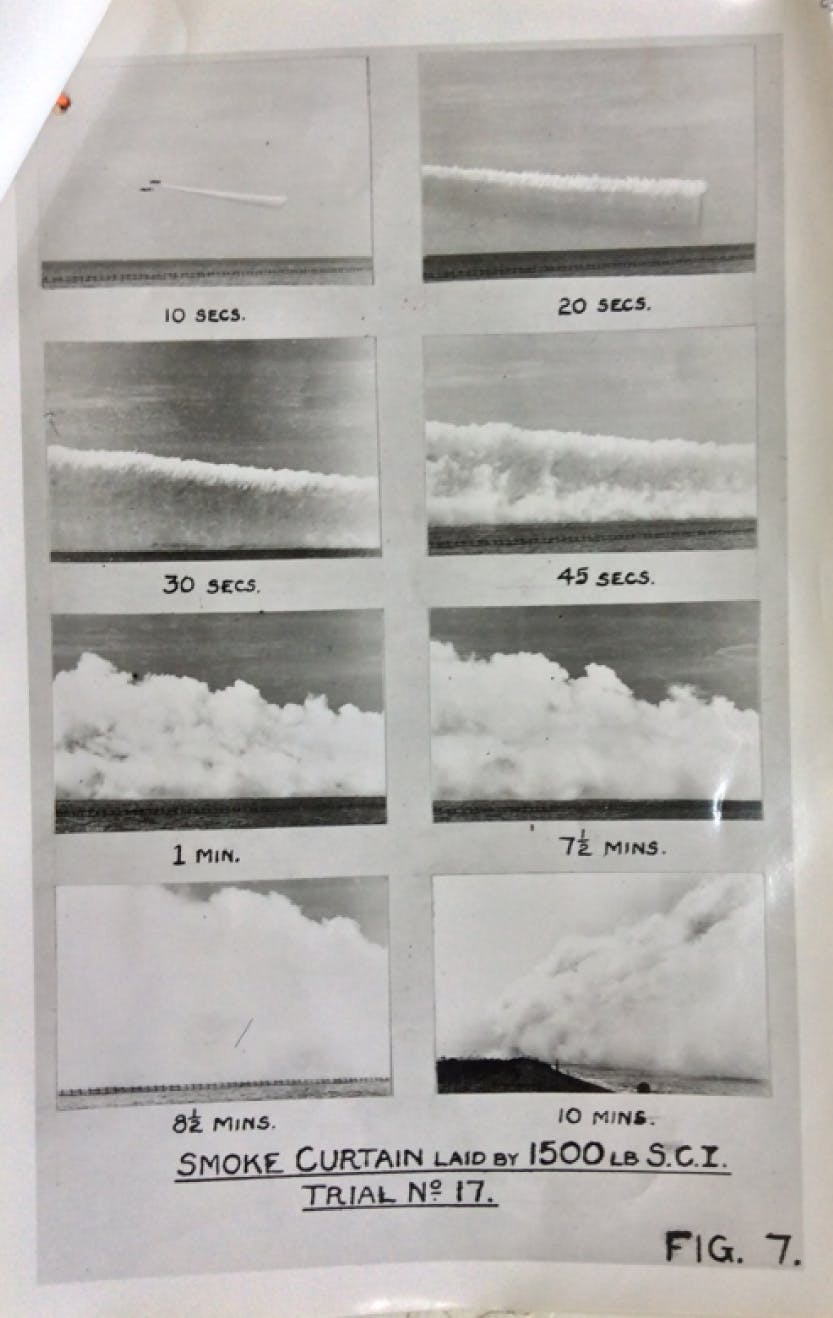Smoke Screen testing at the Great Pagoda
Date: 06 June 2023
Author: Polly Putnam
The explosive history of the pagoda during World War II
The Great Pagoda in Kew Gardens was completed in 1761 for George III's mother, Princess Augusta – it was so tall and impressive that some believed it would collapse. But one of the most surprising periods in its history, discovered by Historic Royal Palaces curators in 2018, is much more modern: its use as a secret testing site during World War II.
Curator Polly Putnam picks up the tale of this fascinating discovery.
During the 2018 restoration of the Great Pagoda, much of the research focused on restoring it to its original 1762 appearance. However, curators wanted to build a complete picture of its history.
One of the most intriguing pieces of information we uncovered was that this imposing building was commandeered by the Royal Aircraft Establishment (RAE): the research arm of the RAF.
Image: The Great Pagoda today. © Historic Royal Palaces

Dropping Bombs at the Royal Botanical Gardens
On 24 March 1941, an order was made to the Ministry of Works to adapt the pagoda to create 'Facilities for Model Bomb Drop experiments'. A shelf was created at the south window of the top floor of the pagoda, above a series of holes made in a straight line down the height of the building.
Evidence for these holes remains today: it's easy to see the repairs, which didn’t take place until the 1950s. They represent extensive damage to the fabric of the building, so of course we wanted to know whether the effort and destruction was worth it.
An extensive trawl through the archives of the RAE at Farnborough and The National Archives proved fruitless. This begged the question: was the notion that the pagoda was requisitioned for 'model bomb drop experiments' deliberate misinformation?
Image: The third floor of the Great Pagoda after restoration in 2018. During the restoration, the Historic Royal Palaces curators compiled a full history of the pagoda and discovered its role during World War II. © Historic Royal Palaces
A Stroke of Luck and a Substantial Clue
Around the same time, I happened to be reading My Family and Other Strangers, the memoirs of the comedian Jeremy Hardy. He mentioned that his father, Donald Hardy had used the pagoda as a ‘bomb testing chute’ during the War. We got in contact with Jeremy who kindly consulted his family. They remembered that his father had helped make smoke bombs in there.
Finally, we had something substantial to research.
Smoke Curtain Installations
Experiments at the Great Pagoda began in the spring and summer of 1942 for 'Smoke Curtain Installations': walls of smoke laid down by aeroplanes to hide ships or troops.
The Navy required that a smoke screen be laid at least 440 yards long. The pagoda was used because it was an enclosed high tower which let the experiments be undertaken at almost full scale; the fourth floor of the Great Pagoda is about 50ft high, which was the height at which smoke curtains were laid down by aircraft.
The scientists were A C Merrington of the CSAR office (Chief Superintendent Armament Research) and Dr Edward Glick Richardson of the RAE (Royal Aircraft Establishment). Jeremy Hardy’s father Donald was an apprentice at the testing site.
The Experiments
A small cordite (a type of gun powder) operated gun was mounted on the fourth floor of the pagoda which was blocked up with cloth and wood to prevent the smoke from rising. Mixtures of titanium tetrachloride and chlorosuplphuric acid were fired from the gun down through the openings in the pagoda floor. The drops of liquid (which failed to turn into smoke) fell into a sandbox on the ground floor.
Camera lamps known as photometers were set up on the first three levels of the pagoda to measure the density of the smoke produced.
Image: Diagram of the experiments undertaken in the Great Pagoda. "The obscuration of Smoke Curtains" by AC Merrington C.S.A.R and E.G Richardson RAE. The National Archives, ref. AVIA 13/770

The Impact of the Smoke Curtain Testing
The experiments at The Great Pagoda in Kew Gardens represented fundamental theoretical research, which led to the development of the delivery mechanism used on the aeroplanes.
There were numerous air trials of the Smoke Curtains at East Wittering and Angmoring on Sea on the Sussex Coast using Beaufort Aircraft. One of the films of these trials has recently been digitised by the Imperial War Museum.
This equipment eventually became the M10 smoke tank.
The M10s were fixed to RAF Boston aircraft and used during Operation Overlord – the D-Day landings at the port of le Havre. On D-Day, 6 June 1944, a three-mile smoke screen hiding allied ships was maintained for three hours by RAF Boston aeroplanes resupplying the smoke every 10 minutes. No ships were hit by German coastal artillery whilst the screen was in place. This was in support of the Allied landings on Juno, Sword and Gold beaches.
RAF pilot Leslie Valentine flew his RAF Boston during these operations, and recalled: "I’d anticipated that it was going to be a little hairy. I had just 46 seconds to let off four canisters of smoke. The Germans were only half a mile back off the beach. The noise of the shells was deafening. Not only was there the chance of being hit in the crossfire but, as the UK forces on the ground were unsure who the aircraft flying so low above them were, they also let fly with small arms fire."
Image: The National Archives, ref. AVIA 13/771

I was flying at 250mph at only 50ft. I had to hold it very steady - at that speed and height if I'd even sneezed that would have been it.
RAF pilot Leslie Valentine
After the war Merrington and Richardson published their research in a paper that is still cited by scientists today.
So next time you climb the pagoda's 253 steps to marvel at the spectacular views, spare a thought for two scientists and their apprentice, dropping smoky mixtures through the Great Pagoda – a building that was really only ever intended as a pretty architectural feature in a royal garden, but played an important role during World War II.
Polly Putnam
Curator, Historic Royal Palaces

More from our blog

Secrets of Henry VIII's Whitehall: The Archaeology of a Lost Palace
17 August 2023
More than 300 years after the destruction of Whitehall Palace by fire, archaeological excavation and scientific analysis continue to uncover the lost stories and secrets of Henry VIII's once elaborate home.

Wren's Royal Palace
08 March 2023
Head of Historic Buildings Daniel Jackson looks at one of Sir Christopher Wren's most famous and problematic projects: the remodelling of Hampton Court Palace.

The Real Norman Hartnell: Beyond 'Silver and Gold'
25 February 2022
February is LGBT+ History Month in the UK, which aims to increase the visibility of lesbian, gay, bisexual and trans (LGBT+) people through the exploration of their history and stories. Collections Curator Matthew Storey looks at one such story.

Anthony Salvin: the architect who transformed the Tower of London
16 December 2021
Archivist Tom Drysdale introduces Anthony Salvin, the Victorian architect who began the transformation of the Tower of London, and looks at four drawings that shed a light on his work and legacy.

